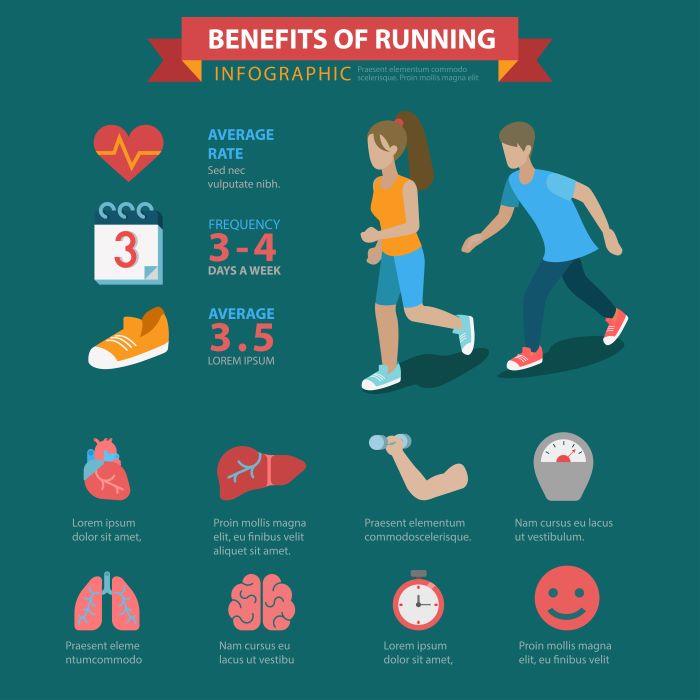Long distance running offers a myriad of health and fitness benefits that extend beyond mere physical conditioning. Engaging in this exhilarating activity not only strengthens the body but also fosters mental resilience and emotional well-being. Here are some notable advantages:
- Cardiovascular Health: Regular long distance running significantly improves heart health by enhancing circulation and reducing the risk of cardiovascular diseases.
- Weight Management: This endurance sport burns a substantial number of calories, making it an excellent choice for individuals aiming to shed excess weight or maintain a healthy body composition.
- Mental Clarity: The rhythmic nature of running releases endorphins, often referred to as the “feel-good” hormones, which can lead to improved mood and reduced anxiety.
- Enhanced Stamina: Consistent training builds endurance, enabling runners to perform daily activities with greater ease and less fatigue.
- Community Connection: Joining local running clubs or participating in events fosters a sense of belonging and support among fellow enthusiasts.
For those who wish to dive deeper into the world of running and explore tailored workouts that suit their individual goals, visit our website to learn more and get started today! Click here.
Exploring Weight Lifting Advantages

Weight lifting, often regarded as a cornerstone of strength training, offers a wealth of benefits that greatly enhance overall fitness and well-being. By incorporating this powerful exercise into your routine, you can unlock numerous physical and mental advantages. Let’s explore some key benefits:
- Muscle Growth: One of the primary advantages of weight lifting is its ability to promote muscle hypertrophy. This not only enhances physical appearance but also contributes to better overall strength.
- Bone Density Improvement: Regular weight training increases bone density, reducing the risk of osteoporosis and fractures as you age.
- Metabolic Boost: Weight lifting elevates your resting metabolic rate, meaning you burn more calories even at rest, which is crucial for weight management.
- Functional Strength: Engaging in compound lifts improves functional strength, making daily activities easier and enhancing performance in other sports.
- Improved Mental Health: The discipline of weight lifting can boost self-esteem and confidence, while also reducing symptoms of anxiety and depression through the release of endorphins.
Embracing weight lifting as part of your fitness journey can lead to transformative changes in your body and mind, paving the way for a healthier lifestyle.
Comparing Endurance and Strength Training

When considering your fitness journey, understanding the differences between endurance and strength training is crucial. Each training type offers unique benefits and caters to different fitness goals, making it essential to choose the right approach for your needs.
Endurance Training focuses on increasing stamina and cardiovascular efficiency. Activities such as long distance running, cycling, or swimming emphasize prolonged physical activity, helping to improve heart health and lung capacity. Key benefits include:
- Enhanced Cardiovascular Health: Regular endurance training strengthens the heart, improving blood circulation and reducing the risk of heart disease.
- Increased Metabolic Rate: Engaging in long-duration aerobic activities helps in burning calories and fat effectively.
- Mental Resilience: Endurance training can boost mental toughness, as it often requires pushing through physical discomfort over extended periods.
In contrast, Strength Training focuses on building muscle mass and power. This form of exercise involves lifting weights or using resistance to stimulate muscle growth. The primary benefits include:
- Improved Muscle Strength: Strength training enhances muscle power, making everyday tasks easier and improving athletic performance.
- Injury Prevention: Stronger muscles and connective tissues lower the risk of injuries during physical activities.
- Body Composition Changes: Building muscle through strength training can lead to more effective fat loss and a better overall physique.
Ultimately, the choice between endurance and strength training comes down to your personal fitness objectives. Many individuals benefit from incorporating both types into their routine for a well-rounded approach to health and fitness.
Assessing Weight Loss and Muscle Gain

When evaluating your fitness journey, it’s important to consider how weight loss and muscle gain can impact your overall health and body composition. Understanding the relationship between these two goals is essential, as they often require different training methods and nutritional strategies.
Weight Loss primarily focuses on creating a calorie deficit, where you burn more calories than you consume. This can be achieved through a combination of:
- Cardiovascular Exercise: Activities like long distance running can significantly contribute to calorie burning, aiding in weight loss.
- Dietary Adjustments: Consuming a balanced diet rich in whole foods while monitoring portion sizes is crucial for successful weight loss.
On the other hand, Muscle Gain involves creating a caloric surplus to fuel muscle growth. This typically requires:
- Strength Training: Lifting weights or performing resistance exercises stimulates muscle hypertrophy, leading to increased muscle mass.
- Higher Protein Intake: Consuming sufficient protein is essential for repairing and building muscle tissue after workouts.
While these goals may seem contradictory, it’s possible to achieve both weight loss and muscle gain simultaneously, especially for beginners or individuals returning to fitness. A strategic approach that combines both strength training and cardiovascular exercise, along with a well-planned diet, can help you effectively navigate these goals.
By understanding the dynamics of weight loss and muscle gain, you can tailor your training program to meet your specific fitness aspirations, ensuring a balanced and sustainable approach to health.
Choosing the Right Exercise for Your Goals
Choosing the right exercise regimen is crucial for achieving your fitness goals, whether you aim to improve endurance, build muscle, or simply enhance your overall health. With varying benefits and challenges, understanding the differences between long distance running and weight lifting can help you make an informed decision.
If your primary goal is to increase endurance and promote cardiovascular health, long distance running is an excellent choice. This form of exercise not only burns significant calories but also strengthens your heart and lungs, enhancing your stamina over time. Additionally, running can be done almost anywhere, making it a versatile option for those who enjoy outdoor activities.
Conversely, if your focus is on building muscle and improving strength, weight lifting is the way to go. Resistance training promotes muscle hypertrophy, leading to increased muscle size and strength. It also aids in boosting your metabolism, which can assist in maintaining a healthy weight. Weight lifting can be tailored to target specific muscle groups, allowing for a comprehensive strength training program.
Your personal preferences and lifestyle should also play a significant role in your choice. Consider factors such as:
- Enjoyment: Choose an activity you enjoy to ensure consistency and commitment.
- Time Availability: Assess how much time you can dedicate to workouts and select exercises that fit within your schedule.
- Access to Facilities: Determine if you have access to running trails or a gym equipped for weight lifting.
Ultimately, the best exercise for you aligns with your goals, interests, and lifestyle. You may even find that incorporating both long distance running and weight lifting into your routine offers a balanced approach to fitness, maximizing the benefits of each discipline.
Creating a Balanced Workout Routine

Creating a balanced workout routine is essential for achieving optimal fitness and overall well-being. A well-structured plan should incorporate various forms of exercise, including cardiovascular activities, strength training, and flexibility exercises. This holistic approach not only enhances physical fitness but also reduces the risk of injury and improves your enjoyment of exercise.
To develop a balanced routine, consider the following components:
- Cardio: Include at least 150 minutes of moderate-intensity aerobic activity, such as long distance running, each week. This helps improve heart health and endurance.
- Strength Training: Aim for two or more days a week dedicated to weight lifting, focusing on all major muscle groups. This promotes muscle growth, strength, and functionality.
- Flexibility and Mobility: Incorporate activities like yoga or stretching exercises to enhance flexibility and prevent stiffness, aiding in recovery and overall performance.
When planning your weekly schedule, strive for a mix of workouts that vary in intensity and type. For instance, you might run on Mondays, lift weights on Wednesdays, and practice yoga on Fridays. This variety keeps your routine engaging and allows different muscle groups to recover while others are worked.
Additionally, listen to your body and adjust your routine based on how you feel. Don’t hesitate to take rest days when needed, as recovery is a vital component of any balanced workout plan. By prioritizing a well-rounded approach to fitness, you can enjoy the numerous benefits of both long distance running and weight lifting.
Visit our website to learn more and get started today! Click here.


